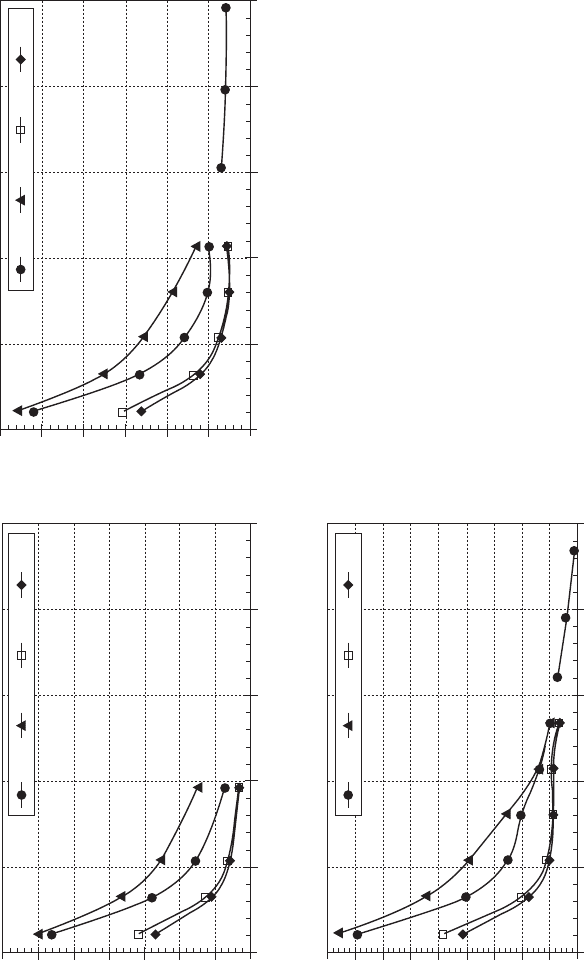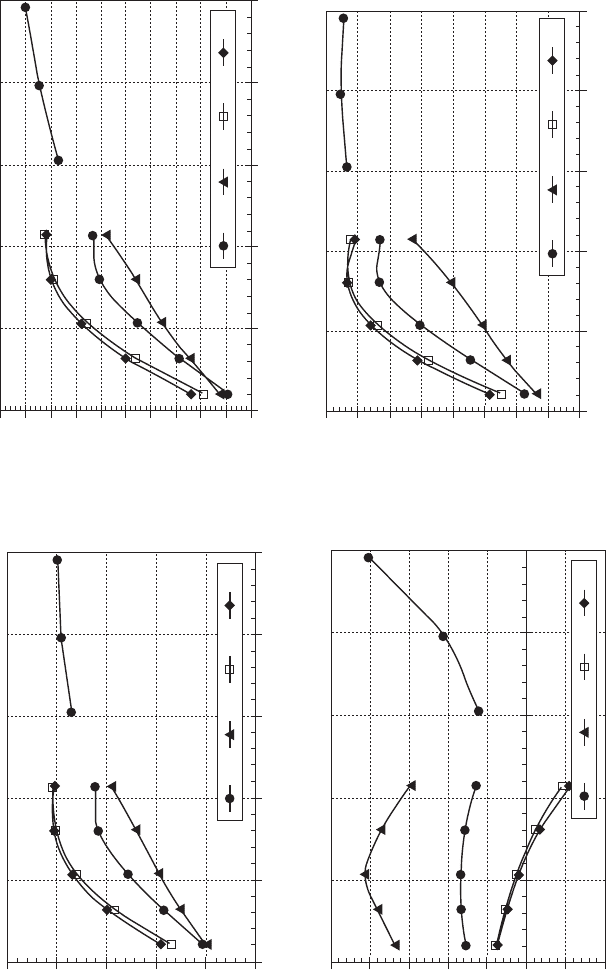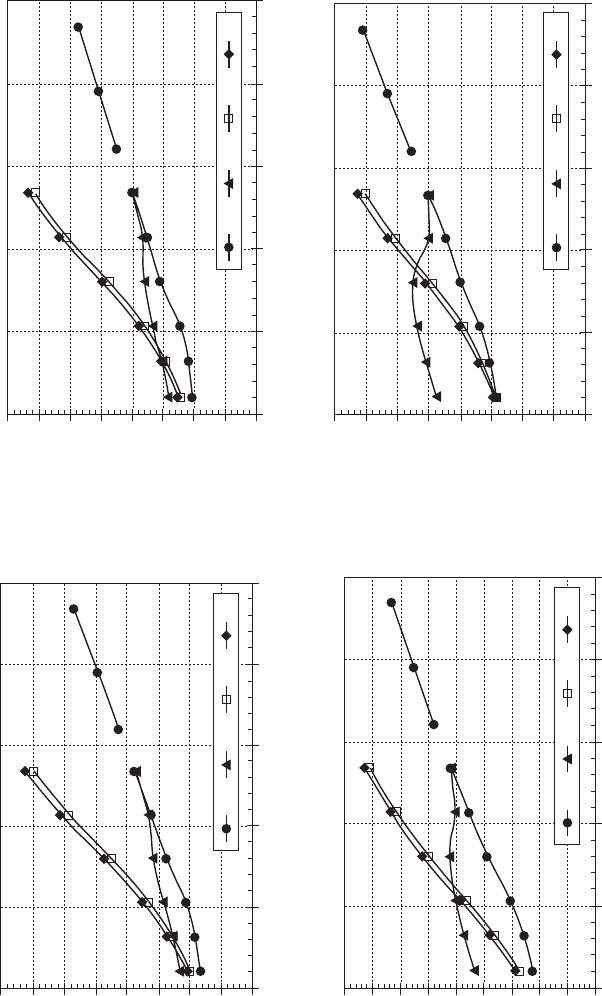Xin Q. Diesel Engine System Design
Подождите немного. Документ загружается.


© Woodhead Publishing Limited, 2011
Simulation of cylinder deactivation at 1000 rpm
Simulation of cylinder deactivation at 1600 rpm
Simulation of cylinder deactivation at 1400 rpm
Simulation of cylinder deactivation at 2000 rpm
S1 S3 S7 S8
S1 S3 S7 S8
S1 S3 S7 S8
S1 S3 S7 S8
0 5 10 15
BMEP (bar)
0 5 10 15 20 25 30
BMEP (bar)
0 5 10 15 20 25 30
BMEP (bar)
0 5 10 15 20 25 30
BMEP (bar)
Overall engine A/F ratio
Overall engine A/F ratio
Overall engine A/F ratio
Overall engine A/F ratio
115
105
95
85
75
65
55
45
35
25
15
95
85
75
65
55
45
35
25
15
95
85
75
65
55
45
35
25
15
105
95
85
75
65
55
45
35
25
15
9.28 Air–fuel ratio of cylinder deactivation at different engine speeds and loads.
Diesel-Xin-09.indd 630 5/5/11 11:59:17 AM

© Woodhead Publishing Limited, 2011
Simulation of cylinder deactivation at 2400 rpm
Simulation of cylinder deactivation at 3000 rpm
Simulation of cylinder deactivation at 2600 rpm
S1 S3 S7 S8 S1 S3 S7 S8
S1 S3 S7 S8
0 5 10 15 20 25
BMEP (bar)
0 5 10 15 20 25
BMEP (bar)
0 5 10 15 20 25
BMEP (bar)
Overall engine A/F ratioOverall engine A/F ratio
Overall engine A/F ratio
85
75
65
55
45
35
25
15
65
60
55
50
45
40
35
30
25
20
75
65
55
45
35
25
15
9.28 Continued
Diesel-Xin-09.indd 631 5/5/11 11:59:17 AM

© Woodhead Publishing Limited, 2011
9.29 Cylinder deactivation performance at 2600 rpm and limiting constraints at 3000 rpm.
Simulation of cylinder deactivation at part load and 2600 rpm
Simulation of cylinder deactivation at part load and 2600 rpm
S1 S3 S7 S8
S1 S3 S7 S8
0 5 10 15 20 25
BMEP (bar)
0 5 10 15 20 25
BMEP (bar)
Exhaust manifold gas
temperature (°F)
LP turbine outlet temperature
(°F)
1400
1300
1200
1100
1000
900
800
700
600
500
400
1100
1000
900
800
700
600
500
400
300
Simulation of cylinder deactivation at part load and 2600 rpm
Simulation of cylinder deactivation at part load and 2600 rpm
S1 S3 S7 S8
S1 S3 S7 S8
0 5 10 15 20 25
BMEP (bar)
0 5 10 15 20 25
BMEP (bar)
Peak cylinder gas temperature of
cylinder 1 (°F)
Engine delta P (back minus
boost, mbar)
3500
3000
2500
2000
1500
1000
1000
800
600
400
200
0
–200
–400
Diesel-Xin-09.indd 632 5/5/11 11:59:17 AM

© Woodhead Publishing Limited, 2011
9.29 Continued
Simulation of cylinder deactivation at part load and 3000 rpm
Simulation of cylinder deactivation at part load and 3000 rpm
S1 S3 S7 S8
S1 S3 S7 S8
0 5 10 15 20 25
BMEP (bar)
0 5 10 15 20 25
BMEP (bar)
Peak cylinder gas pressure (psia,
maximum of all cylinders)
HP compressor of outlet
temperature (°F)
4000
3500
3000
2500
2000
1500
1000
500
0
450
400
350
300
250
200
150
100
50
0
Simulation of cylinder deactivation at part load and 3000 rpm
Simulation of cylinder deactivation at part load and 3000 rpm
S1 S3 S7 S8
S1 S3 S7 S8
0 5 10 15 20 25
BMEP (bar)
0 5 10 15 20 25
BMEP (bar)
Intake manifold boost pressure
(bar, absolute)
Exhaust manifold back pressure
(bar, absolute)
4
3.5
3
2.5
2
1.5
1
0.5
0
4
3.5
3
2.5
2
1.5
1
0.5
0
Diesel-Xin-09.indd 633 5/5/11 11:59:18 AM

© Woodhead Publishing Limited, 2011
Table 9.2 Simulation cases of cylinder deactivation
Scenario
number
Mode Turbine area HP-stage turbine
wastegate
opening
Valvetrain operation Strategy of engine
valve shut-off timing for
deactivated cylinders
S1 Part load Baseline turbine Fully open No cylinder deactivation
S2 High load Baseline turbine Open as needed No cylinder deactivation
S3 Part load Baseline turbine Fully closed No cylinder deactivation
S4 High load Baseline turbine Closed No cylinder deactivation
S5 Part load Baseline turbine Partially closed No cylinder deactivation
S6 Part load Baseline turbine Fully closed Cylinder deactivation by shutting off
fuel only
S7 Part load Baseline turbine Fully closed Cylinder deactivation by shutting off
fuel, intake valve and exhaust valve
(shut-off strategy 1)
Shut-off strategy 1: Shut
off intake valve before each
cylinder’s IVO
S8 Part load Baseline turbine Fully closed Cylinder deactivation by shutting off
fuel, intake valve and exhaust valve
(shut-off strategy 2)
Shut-off strategy 2: Shut
off intake valve after each
cylinder’s IVC
Diesel-Xin-09.indd 634 5/5/11 11:59:18 AM

© Woodhead Publishing Limited, 2011
S9 Part load Baseline turbine Fully closed Cylinder deactivation by shutting off
fuel and only intake valve (shut-off
strategy 1)
Shut-off strategy 1: Shut
off intake valve before each
cylinder’s IVO
S10 Part load Baseline turbine Fully closed Cylinder deactivation by shutting off
fuel and only intake valve (shut-off
strategy 2)
Shut-off strategy 2: Shut
off intake valve after each
cylinder’s IVC
S11 Part load 10% smaller turbine area
in both HP and LP stages
Fully open No cylinder deactivation
S12 High load 10% smaller turbine area
in both HP and LP stages
Open as needed No cylinder deactivation
S13 Part load 10% smaller turbine area
in both HP and LP stages
Fully closed Cylinder deactivation by shutting off
fuel, intake valve and exhaust valve
(shut-off strategy 1)
Shut-off strategy 1: Shut
off intake valve before each
cylinder’s IVO
S14 Part load 10% smaller turbine area
in both HP and LP stages
Fully closed Cylinder deactivation by shutting off
fuel, intake valve and exhaust valve
(shut-off strategy 2)
Shut-off strategy 2: Shut
off intake valve after each
cylinder’s IVC
Note: S9 and S10 have the same steady-state performance.
Diesel-Xin-09.indd 635 5/5/11 11:59:18 AM
636 Diesel engine system design
© Woodhead Publishing Limited, 2011
Figure 9.23 illustrates the speed–load modes used in the GT-POWER
simulation. Note that usually the load range in cylinder deactivation research
is 0–5 bar BMEP, but this simulation extends the load range up to 10–13 bar
BMEP at high speeds greater than 2500 rpm. Figure 9.24 shows the cylinder
pressure traces of different valve switching strategies in deactivation.
Figure 9.25 compares the engine performance given by different deactivation
strategies at 2400 rpm. It can be seen that, compared to the V8 operation
(S1), shutting off only fueling (S6) and shutting off only fueling and intake
valve (S9) do not provide any benet in BSFC reduction. In fact, the BSFC
of S6 and S9 is even higher than that of S1. In S7 and S8, the exhaust valve
is shut off after the intake valve is shut off. Some BSFC benet occurs at
very low load (0–2 bar BMEP) when both the intake and exhaust valves are
closed and a certain amount of air is trapped in the deactivated cylinders
(S8). The largest benet of BSFC reduction occurs with scenario S7 in a wide
range of BMEP (0–10 bar) when very little air is trapped in the deactivated
cylinders.
Figure 9.26 illustrates the effect of 10% smaller turbine area on the
air–fuel ratio. The smaller turbine can increase the air–fuel ratio in the
cylinder deactivation operation in order to extend its operating range to higher
BMEP level. However, the turbine area reduction in a x-geometry turbine
that is sized for achieving higher air–fuel ratio during cylinder deactivation
results in a pumping loss penalty in the non-deactivation operation due to the
excessively high air–fuel ratio. VGT can help alleviate this trade-off between
the cylinder deactivation operation at low loads and the non-deactivation
operation at full load.
Figure 9.27 summarizes the BSFC changes at different speeds and loads
for different turbine wastegate openings (S1 and S3) and deactivation valve
switching strategies (S7 and S8). The lower and upper bounds of the BSFC
reduction benet range bounded by S7 and S8 indicate the two extreme
limits of different valve switching strategies. It is observed that the BSFC
benet is a strong function of both engine load and speed for the diesel
engine. Very large benet of BSFC reduction can be obtained by cylinder
deactivation. Note that the BSFC benet computed here is with respect to a
baseline engine that already has very low BSFC with the turbine wastegate
set fully open at part load by using electronic controls (i.e., S1 rather than
S3). At high engine speeds, the BSFC benet can extend to a very high
BMEP level with acceptable air–fuel ratio (e.g., 10 bar BMEP at 2600
rpm) because the turbocharger can deliver more air than at lower speeds to
maintain a minimum required air–fuel ratio.
Figure 9.28 summarizes the air–fuel ratios corresponding to the cases in
Fig. 9.27. Note that due to reduced air–fuel ratio the cylinder deactivation
operation generally will produce more soot than the non-deactivation operation,
especially when the air–fuel ratio is close to the smoke limit. Other measures
Diesel-Xin-09.indd 636 5/5/11 11:59:18 AM
637Advanced diesel valvetrain system design
© Woodhead Publishing Limited, 2011
(e.g., retarding EVO and advancing IVC with VVA in the ring cylinders)
can be used to reduce the soot at relatively high BMEP level and at low to
medium speeds.
Figure 9.29 illustrates other key performance parameters at 2600 rpm
and the limiting design constraints at 3000 rpm in cylinder deactivation.
It is important to note the effect of cylinder deactivation on the following
two parameters: (1) engine delta P, which is the driving force for EGR ow
in EGR engines and can also be affected by the turbine area selection; and
(2) the low-pressure (LP) stage turbine outlet gas temperature, which can
help the operation and regeneration of aftertreatment devices (e.g., DPF).
Finally, note that the BMEP limit of cylinder deactivation can be restricted
by the peak cylinder pressure in the ring cylinders and the compressor
outlet air temperature at high engine speeds (e.g., 3000 rpm), in addition to
the minimum required air–fuel ratio.
The performance of diesel engine cylinder deactivation is summarized as
follows.
1. The optimum cylinder deactivation method is to shut off fueling and all
the intake and exhaust valves in the deactivated cylinders.
2. The deactivation valve switching timing and gas mass retained in
the deactivated cylinders greatly affect the BSFC benefit of the
deactivation.
3. The optimum number of deactivated cylinders largely depends on the
balance between the air–fuel ratio for combustion/emissions and the
pumping loss for the lowest BSFC. The optimum number is also affected,
although secondarily, by the design features of cylinder heat transfer loss
and piston ring friction of the engine. Deactivating half of the cylinders
may not always be the optimum for achieving the lowest BSFC.
4. Cylinder deactivation provides very large BSFC improvement under
low-load conditions. The benet of BSFC reduction strongly depends
on both BMEP and engine speed for turbocharged diesel engines.
5. BSFC improvement is difcult to achieve with cylinder deactivation at
medium to high loads due to the limit of air–fuel ratio at low to medium
speeds and due to other design constraints at high speeds such as peak
cylinder pressure and compressor outlet air temperature.
6. The extent of BSFC improvement by cylinder deactivation is dependent
upon the following factors: the number of cylinders deactivated, valve
shut-off strategy, valve switching timing, turbine area (variable or xed,
and the area size), turbine wastegate control capability and exibility at
low loads, cylinder heat transfer, and the pressure-dependent portion of
the piston ring friction.
7. As the cylinder heat transfer and piston ring friction loss increase in the
baseline engine design, more benet of BSFC reduction can be achieved
Diesel-Xin-09.indd 637 5/5/11 11:59:18 AM
638 Diesel engine system design
© Woodhead Publishing Limited, 2011
by using cylinder deactivation because a larger portion of the energy
losses can be avoided in the deactivated cylinders.
9.9.4 Design challenges of cylinder deactivation
Engine vibration
NVH and drivability are important concerns for cylinder deactivation. Cylinder
deactivation reduces the frequency and increases the amplitude of engine
vibration at the crankshaft, which may not be acceptable at all engine speeds
in terms of NVH and comfort. The success of cylinder deactivation and
the benet in fuel economy improvement can only be achieved if the NVH
issues are resolved in mass production vehicles. As pointed out by Leone
and Pozar (2001), the benet of BSFC reduction in cylinder deactivation is
constrained or limited by NVH. For example, NVH and drivability concerns
are particularly severe in the rst and second gears of the transmission. If
cylinder deactivation is constrained only to the gears higher than the rst
and second, 2–4% of BSFC reduction benet will not be gained. If cylinder
deactivation is not used during warm-up, another 1–2% of BSFC reduction
benet will not be gained (Leone and Pozar, 2001). The major challenge of
cylinder deactivation is to maximize the fuel economy benet while meeting
the requirements of NVH and drivability in both steady-state operation and
transient transitioning of turning the cylinders on and off (i.e., smooth ramp-
out and ramp-in behavior).
The gas ow through the ring cylinders and the gas pressure pulses in
the manifolds affect the intake and exhaust noises. The cylinder pressure
in the deactivated cylinders plays an important role in engine vibration. As
long as the cylinder pressure is not uniform between the cylinders, engine
vibration and speed variability will increase. The cylinder pressure is affected
by the valve switching strategy in deactivation and is dependent on the air
or gas mass retained in the deactivated cylinders. The regular compression
without shutting off the valves in the non-fueling cylinders balances better
the engine vibration caused by the ring cylinders. With the extreme case of
vacuum compression with both the intake and exhaust valves shut off and
without air mass retained, the engine speed will exhibit higher variability
due to more violent vibration and torque pulsation at the crankshaft. The
higher dynamic torque and the lower frequency associated with the halved
basic engine order in cylinder deactivation cause the vibration amplitude
of the powertrain and drivetrain to increase (Lee and Rahbar, 2005). In
particular, cylinder deactivation used at low idle may create the problem
of excessive NVH due to the very low frequency and high amplitude of
engine vibration at low speed. Watanabe and Fukutani (1982) found that
the amplitude increase of engine vibration in diesel cylinder deactivation at
Diesel-Xin-09.indd 638 5/5/11 11:59:18 AM
639Advanced diesel valvetrain system design
© Woodhead Publishing Limited, 2011
low idle was much larger than that in gasoline cylinder deactivation. The
much higher peak cylinder pressure in the diesel engine was believed to be
the reason.
Potential design improvement in vibration control for cylinder deactivation
includes optimizing the engine mounts, using additional torsional dampers
or isolators in the driveline, increasing the inertia of the rotating engine
components, and increasing torque converter slip (Hatano et al., 1993;
Falkowski et al., 2004), as well as active vibration control measures such
as active tuned absorbers or active engine mounts (Lee and Rahbar, 2005).
However, all these measures have some negative effects. In general, there is no
easy solution for the vibration problem caused by cylinder deactivation. New
technologies are needed to solve the NVH and fuel injection compensation
problems encountered in cylinder deactivation.
Exhaust noise
The engine operating with different number of active cylinders in cylinder
deactivation exhibits different exhaust sound characteristics due to the change
in exhaust pressure waves. The design objective for cylinder deactivation is to
avoid perceivable subjective changes in the tailpipe acoustics. The traditional
active noise control device for this problem in the gasoline engine is usually
to use a ap valve located in the exhaust pipe. The more advanced passive
noise control design is to use passive resonators to attenuate the noise during
the cylinder deactivation operation. Bemman et al. (2005) successfully used
Helmholtz resonators to attenuate the low frequencies inherent to the V4
cylinder deactivation mode for a V8 gasoline engine. Their system is more
cost-effective than the traditional approach of using active valves in the
exhaust system to tune the exhaust noise.
9.9.5 Cylinder deactivation matched with other
technologies
Cylinder deactivation is essentially a technology of variable engine
displacement achieved by VVA to try to optimize fuel consumption at low
loads and obtain high power at high loads. A xed cylinder displacement
downsizing via turbocharging does not have the NVH issues brought by
cylinder deactivation, and may also produce lower parasitic losses. However,
the displacement reduction in xed cylinder displacement downsizing is
severely limited by the achievable power density at full load.
The competing engine technologies for cylinder deactivation in pumping
loss reduction or fuel economy improvement include VVA, VGT, HCCI/CAI,
continuously variable transmission, hybrid electric, and hybrid hydraulic.
Both HCCI/CAI and cylinder deactivation have the potential to decrease
Diesel-Xin-09.indd 639 5/5/11 11:59:18 AM
